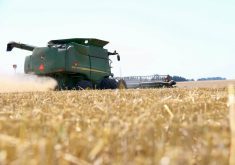Feeder cattle weighing over 700 pounds were a solid $2-$3 per hundredweight (cwt) higher last week; calf prices were steady but also advanced by $2/cwt in certain regions of Western Canada.
Fed cattle prices remained firm in the range of $118-$120.50/cwt in Alberta. The cattle complex appears to have upward momentum moving into the New Year with the deferred live cattle futures leading the charge. CME April live cattle futures made new contract highs touching $138 on Wednesday which set a positive tone for yearlings. Alberta feeding margins are near break-even in the short term while March and April look positive which has given feedlot operators some breathing room when bidding for replacement cattle.
Read Also

U.S. grains: Soybeans hit six-week low as Brazilian harvest looms; corn, wheat sag
Chicago | Reuters – Chicago soybean futures fell to six-week lows on Friday as worries about slowing export demand for…
A small group of exotic steers weighing 520 lbs. sold for $170/cwt north of Calgary. In central Alberta, red Angus steers weighing 660 lbs. sold for $146. A southern Alberta feedlot bought a larger group of greener Simmental mix of 750-lb. steers at $143/cwt. A smaller group of Charolais-cross steers weighing 875 lbs. reached up to $137/cwt in the Lethbridge area. U.S. feeder cattle prices were also $2-$3/cwt on average with the U.S. Department of Agriculture reporting 538-lb. steers selling for $195 in Nebraska.
There was lower buying interest for feather light calves under 400 lbs. last week which I think is an opportunity. These cattle have variable marketing potential but will ultimately be fattened on lower-priced feedgrains in the latter half of the year.
USDA’s cattle on feed report was considered constructive for the cattle market. Dec. 1 on-feed numbers were down six per cent from last year while November placements were also down six per cent. The deferred futures market appears to be incorporating a risk premium due to the uncertainty in beef production. Consumer demand will be the key as expenditures are usually fairly sluggish the first two months of the year.
Look for feeder cattle to continue the slow upward climb into the March period. Strength in the fed market will be the main influence driving feeder cattle higher. Barley prices have been consolidating and there is a seasonal tendency for farmer selling to increase in January and February which will cap upside potential in the short term.
— Jerry Klassen is a commodity market analyst in Winnipeg and maintains an interest in the family feedlot in southern Alberta. He writes an in-depth biweekly commentary, Canadian Feedlot and Cattle Market Analysis, for feedlot operators in Canada. He can be reached by email at [email protected] for questions or comments.















